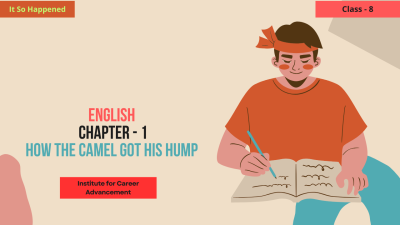Course description
How the Camel Got His Hump - Class 8
Author: Rudyard Kipling
How the Camel Got His Hump is a humorous and imaginative tale from Rudyard Kipling’s Just So Stories. The story explains how the camel, initially lazy and refusing to work, received his hump as a consequence of his idleness. Set in a fantastical world where animals talk and interact with humans, the tale delivers a moral about the importance of hard work and cooperation. Kipling uses humor, imagination, and a light-hearted tone to convey his message, making the story engaging and enjoyable for young readers.
Summary of the Story
The story begins in the early days of the world, when animals had just started working for humans. The horse, dog, and ox complain to the Djinn (a magical being) about the camel, who refuses to contribute to any work, simply saying "Humph!" in response to every request. In response to the complaints, the Djinn punishes the camel by magically giving him a hump, which allows him to store energy and go without food for days. This ensures that the camel can work without needing frequent breaks. From that day on, the camel learns the consequences of laziness and begins to take part in his share of labor.
Key Themes
Consequences of Laziness: The story emphasizes the importance of responsibility and shows how laziness can lead to negative consequences.
Teamwork and Cooperation: It highlights the significance of contributing to group efforts and working together harmoniously.
Imaginative Origin Story: As part of Kipling’s Just So Stories, it uses creativity and humor to explain a natural phenomenon (the camel’s hump).
Moral Development: The tale subtly encourages readers to reflect on their own actions and responsibilities.
Conclusion
How the Camel Got His Hump is an engaging tale that combines humor, imagination, and moral lessons. Through this story, students learn about responsibility, the value of teamwork, and the consequences of laziness in a fun and creative way. The narrative encourages students to reflect on their own behavior while enjoying Kipling’s timeless storytelling style.
কিভাবে উট তার কুঁজো পেয়েছিলাম-ক্লাস 8
লেখকঃ রুডইয়ার্ড কিপলিং
'হাউ দ্য ক্যামেল গট হিজ হাম্প' রুডইয়ার্ড কিপলিং-এর 'জাস্ট সো স্টোরিজ'-এর একটি হাস্যরসাত্মক এবং কল্পনাপ্রসূত গল্প। গল্পটি ব্যাখ্যা করে যে কীভাবে উটটি, প্রাথমিকভাবে অলস এবং কাজ করতে অস্বীকার করে, তার অলসতার ফলস্বরূপ তার কুঁজ পেয়েছিল। একটি কল্পনাপ্রসূত বিশ্বের প্রেক্ষাপটে যেখানে প্রাণীরা মানুষের সাথে কথা বলে এবং যোগাযোগ করে, গল্পটি কঠোর পরিশ্রম এবং সহযোগিতার গুরুত্ব সম্পর্কে একটি নৈতিকতা প্রদান করে। কিপলিং তাঁর বার্তা জানানোর জন্য হাস্যরস, কল্পনা এবং হালকা মনের স্বর ব্যবহার করেন, যা গল্পটিকে তরুণ পাঠকদের জন্য আকর্ষণীয় এবং উপভোগ্য করে তোলে।
গল্পের সারসংক্ষেপ
গল্পটি বিশ্বের প্রথম দিনগুলিতে শুরু হয়, যখন প্রাণীরা সবেমাত্র মানুষের জন্য কাজ শুরু করেছিল। ঘোড়া, কুকুর এবং ষাঁড় জিনের (একটি যাদুকরী প্রাণী) কাছে উট সম্পর্কে অভিযোগ করে, যে কোনও কাজে অবদান রাখতে অস্বীকার করে, কেবল বলে "হামফ!" প্রতিটি অনুরোধের উত্তর দিতে। অভিযোগের জবাবে, জিনটি উটটিকে জাদুকরীভাবে একটি কুঁজো দিয়ে শাস্তি দেয়, যা তাকে শক্তি সঞ্চয় করতে এবং কয়েক দিনের জন্য খাবার ছাড়াই থাকতে দেয়। এটি নিশ্চিত করে যে উটটি ঘন ঘন বিরতির প্রয়োজন ছাড়াই কাজ করতে পারে। সেই দিন থেকে, উটটি অলসতার পরিণতি জানতে পারে এবং তার শ্রমের অংশে অংশ নিতে শুরু করে।
মূল থিম
অলসতার পরিণতিঃ গল্পটি দায়িত্বের গুরুত্বের উপর জোর দেয় এবং দেখায় যে কীভাবে অলসতা নেতিবাচক পরিণতির দিকে নিয়ে যেতে পারে।
দলগত কাজ এবং সহযোগিতাঃ এটি দলগত প্রচেষ্টায় অবদান রাখার এবং সৌহার্দ্যপূর্ণভাবে একসঙ্গে কাজ করার গুরুত্বকে তুলে ধরে।
কল্পনাপ্রসূত উৎসের গল্পঃ কিপলিং-এর জাস্ট সো স্টোরিস-এর অংশ হিসাবে, এটি একটি প্রাকৃতিক ঘটনা (উটের কুঁজ) ব্যাখ্যা করতে সৃজনশীলতা এবং হাস্যরস ব্যবহার করে।
নৈতিক বিকাশঃ গল্পটি সূক্ষ্মভাবে পাঠকদের তাদের নিজস্ব কাজ এবং দায়িত্বগুলি প্রতিফলিত করতে উৎসাহিত করে।
উপসংহার
'হাউ দ্য উট গট হিজ হাম্প' একটি আকর্ষণীয় গল্প যা হাস্যরস, কল্পনা এবং নৈতিক পাঠের সংমিশ্রণ ঘটায়। এই গল্পের মাধ্যমে, শিক্ষার্থীরা একটি মজার এবং সৃজনশীল উপায়ে দায়িত্ব, দলগত কাজের মূল্য এবং অলসতার পরিণতি সম্পর্কে জানতে পারে। আখ্যানটি কিপলিং-এর কালজয়ী গল্প বলার শৈলী উপভোগ করার সময় শিক্ষার্থীদের তাদের নিজস্ব আচরণ প্রতিফলিত করতে উৎসাহিত করে।



















